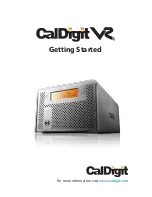
System Overview
18
NAS 2000s Administration Guide
Product Redundancy
The NAS 2000s is specifically designed to perform file serving tasks for networks. Using
industry standard components, redundancy of power supplies, NICs, and fans ensures
reliability.
Other industry standard features, such as redundant array of independent drives (RAID) and
remote manageability, further enhance the overall dependability of the NAS 2000s.
The server contains dual 36.4 GB hard drives preconfigured with the NAS operating system so
that the active system volume is mirrored (RAID 1+0) to the second drive. If one of the
internal drives fails, the integrity of the system is preserved, because the system will use the
copy of the operating system on the remaining healthy drive. The drives in the server are
hot-pluggable, so the failed drive can be replaced while the system is running. When the failed
drive is replaced, the system automatically uses the version of the operating system on the
healthy drive to rebuild the replacement.
The NAS 2000s internal storage server also contains four 146.8 GB hard drives for data
storage. The NAS 2000s external storage server ships with four 146.8 GB hard drives in an
external storage cabinet connected to the Smart Array 6404 controller. These hard drives are
not configured, allowing customizable configuration options. These drives may be configured
to RAID levels 0, 1+0, 5, and Advanced Data Guarding (ADG).
Note:
RAID 1+0 requires an even number of drives.
The NAS 2000s includes dual power supplies. A power supply can be replaced while the
server is running. To ensure redundancy, it is important to connect each power supply to a
separate power source. If one power source fails, the server remains operational through the
second power source.
Through a seamless, hardware-based, graphical remote console, the Integrated Lights-Out port
provides the administrator with full control of the server from a remote location. Using a client
browser, the administrator can remotely power up, power down, and operate the console. A
built in processor makes the port independent of the server and the operating system.
Product Scalability
The NAS 2000s offers optimized performance for a growing environment. Storage capacity
can increase as a business grows without incurring downtime or compromising performance.
The internal model ships with four 146.8 GB disk drives, providing 587.2 GB of raw storage.
The external NAS 2000s model can support up 27 TB of raw storage capacity. This maximum
capacity is achieved by connecting thirteen HP StorageWorks storage enclosures to three
Smart Array 4-port controllers and the integrated SCSI array connector. Each storage
enclosure supports up to fourteen 146.8 GB hard disks, and the NAS system has four
additional SCSI bays, for a total of 186 hard disk drives.
The external NAS 2000s model can support up 27 TB of raw storage capacity. This maximum
capacity is achieved by connecting thirteen HP StorageWorks storage enclosures to three
Smart Array 4-port controllers and the integrated SCSI array connector. Each storage
enclosure supports up to fourteen 146.8 GB hard disks, and the NAS system has four
additional internal SCSI bays, for a total of 186 hard disk drives.
Note:
Each fully populated HP StorageWorks 4300/4400 Family storage enclosure can contain up
to14 hard drives.
Summary of Contents for 345646-001 - StorageWorks NAS 2000s External Storage Server
Page 16: ...About this Guide 16 NAS 2000s Administration Guide ...
Page 56: ...Storage Management Overview 56 NAS 2000s Administration Guide ...
Page 80: ...Disk Management 80 NAS 2000s Administration Guide ...
Page 110: ...User and Group Management 110 NAS 2000s Administration Guide ...
Page 146: ...Folder Printer and Share Management 146 NAS 2000s Administration Guide ...
Page 186: ...NetWare File System Management 186 NAS 2000s Administration Guide ...
















































